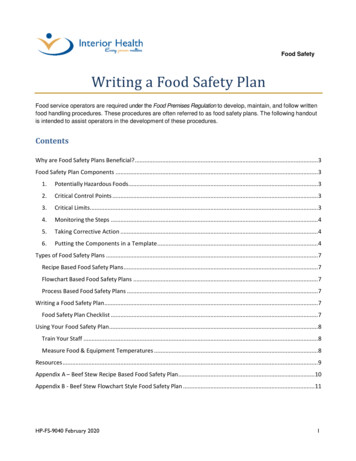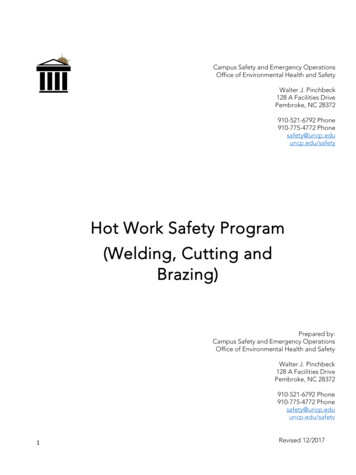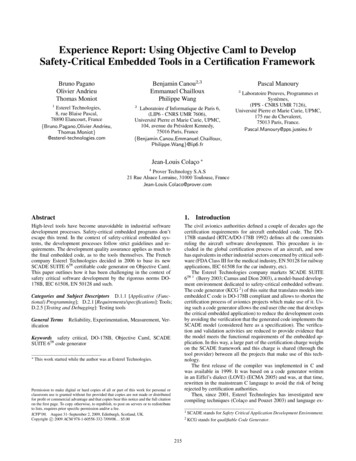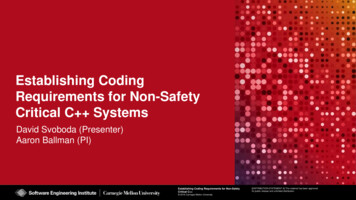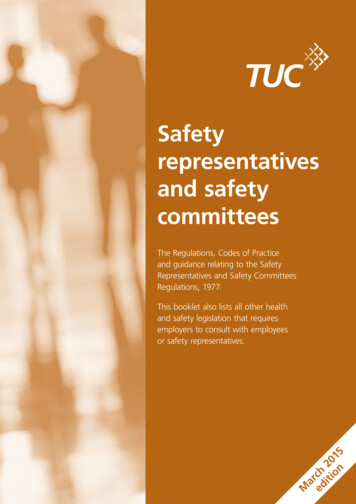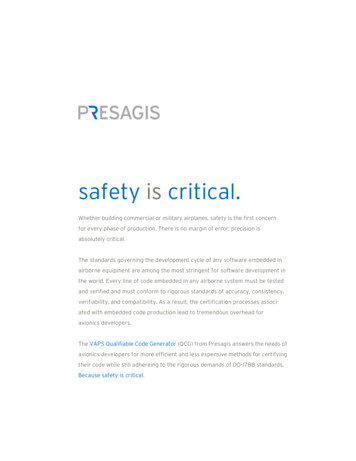
Transcription
safety is critical.Whether building commercial or military airplanes, safety is the first concernfor every phase of production. There is no margin of error; precision isabsolutely critical.The standards governing the development cycle of any software embedded inairborne equipment are among the most stringent for software development inthe world. Every line of code embedded in any airborne system must be testedand verified and must conform to rigorous standards of accuracy, consistency,verifiability, and compatibility. As a result, the certification processes associated with embedded code production lead to tremendous overhead foravionics developers.The VAPS Qualifiable Code Generator (QCG) from Presagis answers the needs ofavionics developers for more efficient and less expensive methods for certifyingtheir code while still adhereing to the rigorous demands of DO-178B standards.Because safety is critical.
2008 Presagis Canada Inc. All rights reserved.Presagis and VAPS are trademarks of Presagis Canada Inc. and/or its subsidiaries or affiliated companies in Canada,United States and other countries. All other trademarks contained herein are the property of their respective owners.
what is do-178b certification?do-178bis the standard that enforces the stringent and rigorousprocess guidelines governing the entire developmentlife-cycle of embedded software in airborne equipment.Set by the Radio Technical Commission for Aeronautics (RTCA), DO-178B ensures thatevery line of code in an embedded airborne system is verified and tested and that itsrequirements conform to strict standards of accuracy, consistency, verifiability, andcompatibility with the target computer. With an emphasis on project management andSoftware Engineering, DO-178B focuses on development processes and their objectives.In DO-178B, “software” pertains to all drivers, Board Support Package (BSP), real-time operating system (RTOS),libraries, graphics, and application software. Developing software for safety-critical certification applications involvesconsiderably more documentation, up-front requirements-based design, requirements traceability, testing, andverification. Software testing means ensuring that the lowest level detailed requirements are accurately implemented,that paths are covered according to their criticality level, and that full traceability is provided.In civil aerospace applications, certification is required for systems whose failure will put human life at risk.Both the Federal Aviation Administration (FAA) in the US and the Joint Aviation Authority (JAA) in Europe recognizeDO-178B\ED-12B (Software Considerations in Airborne Systems and Equipment Certification) as an acceptablestandard for the approval of software in airborne systems. Prepared and maintained by the RTCA and the EuropeanOrganization for Civil Aviation Electronics (EUROCAE), these are the most stringent software certificationstandards in the world.In addition to focusing on the development process for airborne software,DO-178B\ED-12B also concentrates on the evidence required to demonstratecompliance with the various criticality levels. Producing this evidence, whichincludes test archives and traceability documentation, is very labor intensiveand time consuming since every line of code that is produced under aDO-178B\ED-12B project must be traceable back to its original requirement.image courtesy of BARCO
THE EMERGING USE OF COTS TOOLS FOR DO-178BBecause the DO-178B\ED-12B certification process is both labor intensive and timeconsuming, companies are looking for time-saving solutions. One option involves developing proprietary tools in-house or hand-coding; however, companies who have taken thisapproach are discovering that maintaining their in-house tools and/or custom code basesignificantly reduces any benefits associated with hand-coding.Another option is to use Commercial-off-the-shelf (COTS) tools to automate the certification process. The mainbenefit of this COTS approach is that the company realizes significant cost and time savings, in part because it nolonger bears the cost and responsibility of maintaining standard-conformance for the tools. Another benefit is thatdevelopment artifacts for a specific platform configuration can be re-used across multiple projects sharing thatsame configuration, which can lead to further reductions in development time and certification effort.Using COTS tools on either civilor military aerospace avionicsdevelopments leads to substantialcost savings that far outweigh theinitial tool licensing investment,but the real dollar amountsaved depends on the size of thedevelopment effort and on thelevel of certification desired. Manyavionics and aerospace companieshave made or are making the movetowards COTS tools in order totake advantage of the substantialsavings, especially when thesesavings are taken togetherwith the other benefits of thisapproach that include a reductionin code maintenance and greatertechnology development.Figure 1. DO-178B Certification Levels. To further enhance safety critical avionics development,the FAA has issued a series of Technical Standard Orders (TSOs) to identify the required level ofcertification for each device type. This chart shows the different levels of certification that canbe applied to software in an aircraft.
THE BENEFITS OF USING QUALIFIABLE TOOLSTools for DO-178B\ED-12B certification can be categorized as either (1) developmenttools that will produce code that will fly in the aircraft or (2) verification tools that will beused as part of the certification process to verify or check steps but will not produce codethat will fly in the aircraft.DO-178B\ED-12B states that the qualification of a tool is necessary when processes of DO-178B\ED-12B certification are eliminated, reduced, or automated. Tool qualification requires demonstrating a tool’s conformance withDO-178B\ED-12B in the same way that the developer’s end product is to be certified. Concerning the qualificationof software development tools, DO-178B\ED-12B goes further to state that the development processes for suchtools should satisfy the same objectives as the software development processes of airborne software. As a result,the software level assigned to the tool should be the same as the level for the airborne software that it produces.Thus, the main advantage of using a qualified tool is that the user can automate or reduce the level of effortspent on certification, and these reductions can only be achieved by using “qualifiable” development tools.Non-qualifiable tools do not reduce the effort of final certification because the user is forced to undertakeall of the documentation and testing as if no tool had been used, a process that is bothtime consuming and costly.
VAPS QCG OVERVIEWvaps qcgThe VAPS software tool suite from Presagis is a premierCOTS solution for embedded software certificationbecause it is both a qualifiable development tool as well as a qualifiable verification tool.VAPS is recognized as the industry standard for the rapid prototyping, designing, testing, and deploying of aerospaceHuman Machine Interfaces (HMI). Used by teams to jointly design and test the look, feel, functionality, and behaviorof a particular embedded system or group of embeddeddisplay units, VAPS enables the development of dynamic,interactive, real-time graphical HMIs for safety criticalembedded devices in aircraft. With the addition ofthe VAPS Qualifiable Code Generator (QCG) andVAPS DesignDoc, the VAPS tool suite is a qualifiableCOTS tool that greatly reduces the cost of embeddedsoftware certification.Qualifiable to RTCA DO-178B level A, VAPS QCG is acode generation solution for deploying VAPS applicationsto a safety critical embedded system, including aircraftcockpit display systems. Since VAPS QCG is coupled withthe VAPS graphical design environment, this tool enablesgraphics software generated from a VAPS application tobe certified with a minimum of effort. By greatly reducingthe effort required within the software design, coding,and testing phases of the graphics display developmentlifecycle, VAPS QCG dramatically shortens the timerequired for developing certifiable embedded softwareproducts.Figure 2. Embedded Systems using VAPS QCGPorting LayerRun Time LibrariesGenerated CodeUser CodeThe VAPS QCG Porting Layer is a thinlayer of code that abstracts platformdependencies, thereby allowing VAPSQCG to be easily ported to arbitraryplatforms. The porting layer can eitherbe coded by the customer or by thePresagis Professional Services Group.The VAPS QCG Run Time Libraries contain the functions to implement genericVAPS behavior. These libraries have nodependencies on any external softwareother than the VAPS QCG portinglayer, making them easily portable. Thelibraries are written and provided byPresagis and do not need to be modified.This layer of code implements thefunctionality as defined by the VAPSmodel. The generated code is specificto each application.User code typically performs I/O,any additional data processing, fillsVAPS QCG channel buffers, and callsVAPS QCG to draw.
Designed to generate code in a consistent and reliable way, VAPS QCG eliminates the need for the manual coding ofVAPS graphics, logic, and behavior. VAPS QCG may also be used to generate either desktop executables for review andprototyping purposes or highly optimized code for porting to embedded systems. The optimizations include reducedgenerated code size, reduced frame loading time, reduced run time transformations, and increased drawing speed.The entire process, from the creation of a VAPS model to a fully functional executable, can take just a few minutes.The result is a reliable process that saves significant amounts of time in both the design and verification phases ofembedded development, as well as reduces dependencies for specialized internal skill sets.Figure 3. Realize time/cost savings by using VAPS to model graphics from the generation of system requirements through to the designphase of a project and by using VAPS QCG to generate code from design through to the implementation phase. In addition, reduce lowlevel testing with the QCG and Run Time Libraries.
Detailed documentation describingthe HMI specification must be written in the initial stages of development and must be kept up-to-date asthe product evolves. VAPS DesignDocoutputs Microsoft Word documentsdetailing all aspects of a VAPS-builtHMI by automatically querying thedesign files for all required documentation details. With VAPS DesignDoc,the user has complete control overthe appearance of the document. Inaddition, once the template is written,if the application should be updatedor changed in any way, the user simply needs to re-run VAPS DesignDocin order to automatically create anew up-to-date document in a matterof seconds. Because DesignDoc isqualifiable as a verification tool, it canbe used to review the VAPS designfiles and low level requirements (LLR)against high level requirements(HLR).Figure 4. Traditional hand-coding and certification of embedded displays can result in delays andcost overruns in both the development and certification processes. Using VAPS QCG, togetherwith repeatable, proven processes, reduces risk and facilitates better time to market.When using Telelogic DOORS, theVAPS integration with DOORS allowsthe user to link DOORS requirementIDs to VAPS objects. This allows the user to maintain traceability for the VAPS application within DOORS. As theDOORS requirement IDs are saved in VAPS as well, they are included in documents generated by DesignDoc, thusfacilitating review.
VAPS QCG PACKAGING & TECHNICAL OVERVIEWVAPS QCG includes the following elements:Code Generator & Run Time LibrariesVAPS Developer LicenseTelelogic DOORS interface licenseVAPS QCG is a code generator that generatesembeddable C-code directly from VAPS Metafilesfor applications requiring DO-178B level A orED-12B certification.VAPS Developer is used to model HMI applicationsfor embedded avionics systems.This interface integrates VAPS with DOORS, themost popular requirement traceability product,to enhance users’ control of their deliverablesby providing a link between the original productrequirements and the end product.VAPS QCG Certification Kit (optional):DO-178B Artifacts Plan for Software Aspects of Certification(PSAC)Software Accomplishment Summary (SAS)Software Configuration Index (SCI)VAPS QCG Run Time Design documentsVAPS QCG High Level Run Time behaviortest casesAccess to complete VAPS QCG developmentartifactsVAPS DesignDocThe certification kit provides all of the necessarycertification artifacts in support of a customer’scertification efforts. Presagis DesignDoc is a“verification” tool included in the VAPS QCGCertification Kit that facilitates the review ofVAPS design files against original high level customer design requirements as part of the necessarycertification process. DesignDoc is qualifiable asa verification tool under DO-178B in support ofthese programs.Target Platform SupportCode LanguageVAPS QCG supports virtually all embedded target platform configurationsthrough a porting layer, including – but not limited to – combinations of thefollowing popular products:Both the QCG generated code and Run Time Libraries are a subset of ANSI Cin accordance with Motor Industry Software Reliability Association (MISRA)guidelines.Real-time Operating System Support Wind River VxWorks AE653Green Hills Integrity-178Drivers Support Seaweed Systems SeaWind/178 Certifiable Graphics SoftwareAlt Software DO-178B driversDownward compatibilityApplications developed for VAPS QCG may also be code generated using thefollowing Presagis code generators: VAPS C-code Generator (CCG) VAPS CCG LiteEmbedded Computing GE FanucCurtiss WrightVAPS Qualifiable “Mode”The Qualifiable “Mode,” an additional time saving feature in VAPS, allows users to validate that the VAPS application is QCG ‘compliant’ beforeusing VAPS QCG to generate the code. The validation process ungroups, removes, or changes invalid VAPS objects, files, and channels found inthe VAPS application. While manually validating an application containing hundreds or even thousands of files would be a tremendously timeconsuming process, any VAPS application can be quickly and automatically validated by using the VAPS Qualifiable mode. Once the validationprocess has been completed, the user can proceed with VAPS QCG code generation.
PROFESSIONAL SERVICES & DO-178B CONSULTINGLook to Presagis Professional Services for further time and cost savingsThe following professional services packages from Presagis can help to both shorten developmenttime-to-market and reduce the cost of safety-critical embedded display projects:Program Start Up“Program Start Up” is targeted to customers who are undertaking a new project, are currently lacking sufficient tool experience, are under strict deadline, or are eager to show early proof of concepts. A perfectcomplement to both our training courses and award-winning documentation, the “Program Start Up” package gives users the opportunity to learn about their Presagis products directly from an expert who will alsoproperly install and configure these tools. Using “Program Start Up” can dramatically improve quality whileaccelerating development. It can also help users to reduce both ramp-up time and business risk throughthe efficient and focused configuring of the Presagis products required for their project.Expert HelpPresagis maintains some of the top embedded and simulation talent in the world. With over ten years ofexperience helping customers to successfully accelerate their programs, Presagis consultants have the necessary skills and expertise to lower costs and reduce business risk. During the initial planning stages, “ExpertHelp” provides Evaluation Assistance for customers interested in evaluating the technology before investingin the products. During development, customers use the “Expert Help” service as a resource to complementtheir own staff; Presagis consultants are developers and subject matter experts who help to reduce the costsassociated with training staff in seldom used skill sets and with extended ramp-up times.Content CreationPresagis Professional Services offers customers the opportunity to outsource their embedded and simulation content creation needs to experienced and qualified Presagis consultants. With the “Content Creation”service package, Presagis consultants ensure that customer specifications are properly specified and thendevelop high quality content either on site or remotely. The outsourcing option provided by this service package is a perfect solution for customers concerned about meeting program deadlines or requiring critical pathassistance. The package is also an ideal way to reduce business risk and to save on having to hire or developin-house specialized skill sets since content creation is done by subject matter experts.
CASE STUDYThe following is a high level description ofa typical Original Equipment Manufacturer(OEM)/Supplier relationship within thedevelopment of an avionics display system.While this Case Study explains the uses ofVAPS QCG within a particular workflow, thevarious roles of the supplier and OEM coulddiffer from this example. T\aP XS a c ch X]Vb TRXUXRPcX ]bTPbX[h XcTaPcT\d[cX [T 7 8b aTeXbX ]b RP] QT TPbX[h bT]c c bd [XTaThe first step involves the OEM creating a detailedsystem specification that includes the following: HMI specifications, including VAPS design files. Software architecture requirements, includingthe real-time operating system selection. Hardware parameters. Many other relevant system details. continuedbd [XTaT\QTSSTS bhbcT\aTSdRT R \ [TgXchTPbX[h \ ST[ VaP WXRb VT]TaPcT TgTRdcPQ[TbPdc \PcX ] \TP]b UTfTa b TRXP[XiTS bZX[[bR ST VT]TaPcTS P [XRPcX ]eP b RVeP b RV ad] cX\T [XQaPaXTbeP b RV acX]V [PhTaeP b RV acSTbXV] UX[Tb W\X b TRXUXRPcX ]beP b RV P [XRPcX ]dbTa X]cTVaPcX ] R STaTP[ cX\T TaPcX]V bhbcT\SaXeTabSTbXV] UX[Tb W\X b TRXUXRPcX ]bT\QTSSTS R \ dcX]V [PcU a\[PcU a\ R ]UXVSTbXV] UX[Tb W\X b TRXUXRPcX ]bFigure 5. Using VAPS QCG, the OEM can easily communicate design requirements to the supplier, allowing the supplier to makemodifications and to communicate the results back to the customer—often within minutes. Customers also save additional timeand money by re-using the underlying platform architecture and porting layers on subsequent projects.RaTPcT ]RTaTdbT eP b RV ac PRa bb \d[cX [T 7 8b
Then, the supplier uses the system specification docu-The benefits for the OEM of using the VAPS QCGment as a primary guideline for the development of theapproach are as follows:system. To begin, the supplier develops the integrated The OEM has complete control and ownershiphardware and driver platform and then integrates andof the display format and resulting Intellectualoptimizes the RTOS for the target hardware. The sup-Property (IP).plier then ports the VAPS QCG Run Time Libraries to the Changes to the VAPS display format can be easilytarget RTOS/Hardware platform, resulting in a platformcommunicated to the supplier and implementedthat does not need to be modified for each subsequentin a matter of minutes without any modificationHMI application and system. This porting activity canto the underlying platform.also be accomplished by the Presagis Professional Development artifacts used in a VAPS QCG portfor a specific platform configuration can be re-Services group.used across multiple projects sharing that sameNext, the supplier code generates the VAPS Design Filesconfiguration, thereby leading to importantfor the target platform by using VAPS QCG. Changes toreductions in development time and certificationthe HMI specification can now be immediately deployedeffort.to the target system using VAPS QCG automatic code New HMI applications can be developed andhave code generated to the target platform asgeneration.well, resulting in additional time/cost savings.In the final step, the system is certified DO-178B jointly The use of COTS tools provides the OEM withby the OEM and the supplier. Since VAPS QCG is athe option to take more control of the projectqualifiable tool to be used under DO-178B, this mustby choosing to perform the VAPS QCG portingbe declared in the end-user system PSAC. The supplierwork without the need for specialist knowledge.performs the low level verification of the porting layer, The use of VAPS QCG on subsequent projectswhich can, in turn, be used across multiple projects. Ingreatly reduces risk because VAPS QCG willaddition, verification of the VAPS HMI is performed ashave been recognized as certifiable onpart of the complete system validation and testing. Atprevious projects.this point, DesignDoc automatically generates detaileddocuments, including display formats, that are extremelyThe VAPS approach also provides the supplier withuseful for verification activities.the following benefits: Fewer programming and specialized skill setsrequired. Faster time to market, greater reliability, andoverall better service to the OEM.
FAQWhen was VAPS QCG first launched?VAPS QCG was launched in 2000 with internationalDoes Presagis plan to continue supporting VAPS QCG foryears to come?customer involvement, including Eurocopter, Barco,Absolutely. DO-178B certification is becoming in-Smiths, and Elbit.creasingly important to customers, and Presagis willsupport VAPS QCG for as long as necessary in orderHow does the VAPS/DOORS integration save time into support its growing user base.verification?The VAPS/DOORS interface enhances the user’sHow does DesignDoc automatically generate docu-control of deliverables by providing a link betweenmentation for verification?the original system requirements and the implemen-VAPS DesignDoc uses a proprietary technologytation. The interface provides the capability to assignto output Microsoft Word documents detailing alla DOORS requirement ID to VAPS objects, makingaspects of a VAPS-built HMI by querying the designit simpler to track changes for hundreds, or evenfiles for all the required details. Because DesignDocthousands, of objects. The requirements and objectsis qualifiable as a verification tool, it can be used toare reusable from project to project, thereby furtherreview the VAPS design files and low level require-reducing time and cost.ments (LLR) against high level requirements (HLR).When using Telelogic DOORS, the VAPS integrationWhich is the proper term used to describe VAPS QCG –with DOORS allows the user to link DOORS require-qualifiable or qualified?ment IDs to VAPS objects. This allows the user toVAPS QCG has been developed to conform to DO-maintain traceability for the VAPS application within178B as a development tool and is thus qualifiable.DOORS. As the DOORS requirement IDs are saved inAs per DO-178B, tools can only be qualified on aVAPS as well, they are included in documents gener-given project. VAPS QCG has been qualified onated by DesignDoc, thus facilitating review.a number of projects using the Certification Kit‘off-the-shelf’.Do I have access to the full set of certification artifactsfor VAPS QCG?How many programs has VAPS QCG been qualified on?Today there are more than 15 programs using VAPSThe full set of artifacts is available, providing that theVAPS QCG Certification Kit was purchased.QCG, with more being added every month. Ask yoursales representative for a complete list.How much time and cost savings can I realistically expectto achieve using this product?Time and cost savings are tightly linked to severalfactors, including the number of engineers workingon the project, user experience, and the complexity
VAPS QCG CUSTOMERSof the actual application being built. Specific users have indi-THALES Avionicscated that 70-80% time savings across an entire project is notProject: Helicopteran unrealistic metric. It is advisable to speak with your salesrepresentative in order to help you work through a sampleproject in order to get an accurate estimate for your specificdeliverable.ProjectsDATELProject: PilatusPC21ELBITProject: EurocopterI am concerned about performance. Are there metrics avail-BAE Systemsable for final systems developed using VAPS QCG?Project: EurofighterPerformance will be dictated largely by the target platformand the complexity of the application; however, with VAPSQCG, users can expect excellent performance for most mainstream avionics applications. VAPS QCG has met or exceededembedded refresh targets on some of the most demandingProject: FastJet ProgrammesBARCOProject: EurocopterSMITHSfor specific platform/application metrics examples.Project: Helicopterembedded system. Can I still use VAPS QCG?Yes. The porting layer allows VAPS applications to be portedsuccessfully to any embedded target, even proprietary ones.TyphoonGALILEOcustomer applications. Speak with your sales representativeI have a proprietary target platform requirement for myTigerSuper PumaProjectsBARCOProject: PilatusPC21EADSProject: AircraftProgramBARCOAre Presagis VAPS QCG engineers available in order to helpme through my certification project if necessary?Yes. The product architect and the VAPS QCG engineeringteam are available and have helped many customers withcertifications in the past. Additionally, Presagis ProfessionalServices team is always available for any special or customwork that may need to be done on your project.Project: Saras(Indian Aircraft)LOCKHEED MARTIN (Owego)Project: US101(Presidential Helicopter)LOCKHEED MARTIN (Marietta)Project: C5AmpCMC ELECTRONICSProject: MilitaryAircraft Program
NOTES
talk to us.Your feedback is important to us.At Presagis, we want to ensure that our solutions meet our customers’ needs.With the integration of object-oriented menus, 2D moving maps, 3D, and livevideo into commercial and military cockpits, safety-critical standards will nowapply to a whole new generation of technology.By working to keep VAPS QCG at the forefront of innovation, Presagis ensuresthat our qualifiable code generator will help avionics developers to certify theirsoftware efficiently for all current and future elements of their embedded system.We welcome the opportunity to discuss how VAPS QCG can help you to meetyour project’s certification needs.sales officespresagis worldwide4700 de la Savane, Suite 300Montréal (Québec)H4P 1T7 Canada3 1 514 341·3874 1 800 361·64245 1 514 341·8018presagis usa1301 W. George Bush FreewaySuite 120Richardson, TX 75080 USA3 1 972 943·24005 1 469 467·4563presagis UNITED KINGDOMSt. Mary’s House, 40 London RoadNewbury, BerkshireRG14 1LA U.K.3 44 (0) 1635·262·7245 44 (0) 1635·528·701presagis FRANCE41 bis, Avenue de L’Europe78140 VélizyFrance3 33 (0) 1·34·63·02·465 33 (0) 1·34·63·02·48
do-178b is the standard that enforces the stringent and rigorous process guidelines governing the entire development life-cycle of embedded software in airborne equipment. Set by the Radio Technical Commission for Aeronautics (RTCA), DO-178B ensures that every line of code in an embedded airborne system is verified and tested and that its




